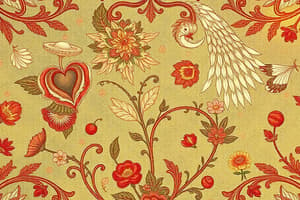Podcast
Questions and Answers
In which year did the loss of value in savings peak significantly after World War II due to lifted price controls?
In which year did the loss of value in savings peak significantly after World War II due to lifted price controls?
- 1947
- 1946 (correct)
- 1945
- 1944
What was the loss in value of savings in the year 1941?
What was the loss in value of savings in the year 1941?
- Over 12%
- Over 15%
- Over 9% (correct)
- Over 5%
What was the reduction in value of a $1 million retirement fund during the First World War?
What was the reduction in value of a $1 million retirement fund during the First World War?
- $750,000
- $600,000
- $659,000 (correct)
- $800,000
What does the author suggest about negative real interest rates over time?
What does the author suggest about negative real interest rates over time?
How are savers affected by income taxes according to the author?
How are savers affected by income taxes according to the author?
What consequence did previous wars have on retired individuals' savings?
What consequence did previous wars have on retired individuals' savings?
What historical trend does the author imply regarding wars and savings for millions?
What historical trend does the author imply regarding wars and savings for millions?
What happens to real interest rates during periods of war?
What happens to real interest rates during periods of war?
How does inflation function during wartime according to the passage?
How does inflation function during wartime according to the passage?
Which war saw the worst annual impact on real interest rates in 1917?
Which war saw the worst annual impact on real interest rates in 1917?
What short-term investment instrument was used for research on real interest rates?
What short-term investment instrument was used for research on real interest rates?
During which war did real interest rates remain negative for the longest duration?
During which war did real interest rates remain negative for the longest duration?
In what year did the Korean War see the worst real interest rate loss?
In what year did the Korean War see the worst real interest rate loss?
What is the effect of an increase in the supply of dollars during war?
What is the effect of an increase in the supply of dollars during war?
What was the magnitude of the real interest rate decline in 1974 during the Vietnam War?
What was the magnitude of the real interest rate decline in 1974 during the Vietnam War?
Flashcards
Negative real interest rates
Negative real interest rates
The value of your savings declines because inflation is higher than interest rates you earn.
Inflation tax
Inflation tax
The hidden tax imposed by inflation during times of war.
Real interest rate
Real interest rate
A measure of how much the value of your savings decreases due to inflation.
U.S. Treasury Bills
U.S. Treasury Bills
Signup and view all the flashcards
Negative real interest rate period
Negative real interest rate period
Signup and view all the flashcards
Inflation rate
Inflation rate
Signup and view all the flashcards
Nominal interest rate
Nominal interest rate
Signup and view all the flashcards
Adjusting for inflation
Adjusting for inflation
Signup and view all the flashcards
Inflation
Inflation
Signup and view all the flashcards
1946 Post-War Inflation
1946 Post-War Inflation
Signup and view all the flashcards
Inflation's Impact on Savings
Inflation's Impact on Savings
Signup and view all the flashcards
Taxes and Real Interest Rates
Taxes and Real Interest Rates
Signup and view all the flashcards
Wars and Inflation
Wars and Inflation
Signup and view all the flashcards
Study Notes
Negative Real Interest Rates During War
- Wars can lead to negative real interest rates, eroding savings' buying power due to inflation.
- Inflation is a hidden tax as the government prints money to fund war, causing each dollar to lose value.
- This loss is reflected in rising prices, effectively taking a portion of savings' value.
Historical Impact of Wars on Real Interest Rates
- Examining past major U.S. wars (World War I, World War II, Korean War, Vietnam War), short-term interest rates and Consumer Price Index (CPI) changes were analyzed to assess real interest rates.
- Short-term U.S. Treasury Bill rates are safer during inflation than longer-term options.
- In all four wars studied, real interest rates went negative.
Specific War-time Examples
- Korean War (1950): Real interest rates reached a negative 4.5%, representing a 4.5% loss in savings' buying power in one year.
- World War I (1917): The government would have consumed 16% of savings in the worst year. A $1 million retirement fund in 1917 would have been down to $659,000 after 3 years due to severe price rises compared to interest rates.
- World War II (1941 & 1946): Loss of over 9% and 17% of savings, respectively. The worst impact occurred in 1946, after price controls were lifted.
- Vietnam War (1974): Negative interest rates lasted for seven years, with a 5% loss in savings' value in its worst year.
Implications for Savers
- Extended periods of negative real interest rates can significantly diminish savings.
- Income taxes compound the effect, as taxes are levied on the advertised rate, not the real rate.
- Historical data suggest a high chance of millions losing savings during prolonged wars.
- Speaking with people who experienced previous wars can provide insights on the detrimental effect of inflation on long-term savings plans.
Studying That Suits You
Use AI to generate personalized quizzes and flashcards to suit your learning preferences.




